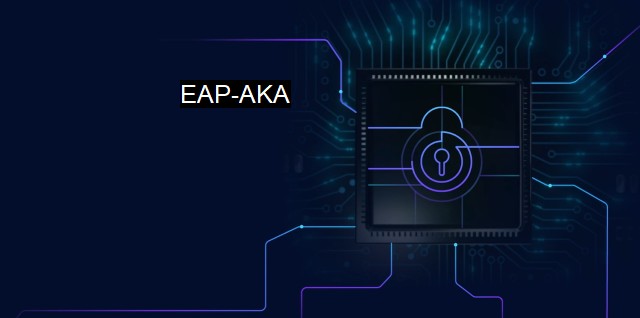What is EAP-AKA?
Understanding the Significance of EAP-AKA Protocol in Securing Mobile Device Access: A Comprehensive Overview
EAP-AKA, or Extensible Authentication Protocol-Authentication and Key Agreement, is a 3GPP-defined mechanism utilized in providing secure communication in wireless systems. Typically employed within the cybersecurity and antivirus domains, EAP-AKA is a protocol that inherently operates under an umbrella of the Extensible Authentication Protocol (EAP), a universal authentication structure pertaining to wireless networks.EAP-AKA engages in mutual authentication, where both the server and the client authenticate each other. its delineation incorporates a critical method for generating and mutually agreeing upon a shared encryption key. By using a master key held by the user's home network, this end-to-end privacy-protection mechanism significantly enhances the security aspect in the entire communication chain.
Derived from the Universal Mobile Telecommunications System (UMTS) AKA and supplemental to GSM/3G networks, EAP-AKA is powerful enough to resist the malicious entities trying to intrude onto networks or services. The advantages of EAP-AKA include anonymity support, prevention of fraudulent network access by devices that try to mimic as legitimate users, and protection against disclosures of permanent user identification. Its credence is further elevated with enhancements like pseudonym identity, fast re-authentication and support for cryptographic separation, all of which are fundamental to advancing cybersecurity.
EAP-AKA operates on the client-server model. The home network of the client, the telecom operator, stands as the server or 'verifier' that validates the authentication of the user alongside several other devices. In turn, the protected and safe communication and exchange of data from both ends is ensured.
SIM (Subscriber Identity Module) cards lay immense importance in the effective functioning of EAPI-AKA. Briefly stated, the protocol remains stored in the SIM card as an application on the card and utilizes SIM card content during for authorization processes.
The entire process occurs in three main steps: authentication and key distribution, mutual authentication and key agreement, synchronization. Before developing an encrypted connection, EAPI-AKA verifies the 'authenticity' of clients by way of ABS (Anonymity Bootstrapping for Signatures). The avoidance of phishing, mid-man attacks and interception by any unauthorized personnel is rendered feasible by EAP-AKA's strict conformity to confidentiality and anonymity.
Central to EAP-AKA, ABS allows initial trust establishment with a third-party certificate. This way, while maintaining a degree of anonymity for the user, it guarantees the actual identification of the user at the same time.
Importantly, due to its extensible nature, the EAP-AKA has the capability to easily accommodate new services on its palette, without necessitating updates to the protocol. The latters' addition as new subscribers or operators on the network level circumvent existing security algorithms from meddling with authentications proceedings.
As for antivirus context, EAP-AKA plays an essential role as a guard against unauthorized augmentations to system files. It ensures secure communication between untrusted peers whilst allowing for modification of data transmission by only the authorized parties, thereby prohibiting unwanted parties from executing file transfers or alterations.
EAP-AKA is an imperative protocol promoting cybersecurity. It attests users' identities, maintains anonymity and privacy-guarding practices, and supervises the secure communication across networks. It underlines robust security measures for the effective management of mobile device systems and Wi-Fi networks. It's advantageous in thwarting authentication-based attacks and prohibits unauthorized access, ensuring the overall cyber safety of connected devices and systems, thereby playing major roles within fields of antivirus and cybersecurity.

EAP-AKA FAQs
What is EAP-AKA?
EAP-AKA (Extensible Authentication Protocol Authentication and Key Agreement) is a protocol used for secure authentication and key agreement between a client device and an authentication server. It is commonly used in mobile communication networks for the authentication of devices and users.How does EAP-AKA provide security against cyber threats?
EAP-AKA provides security against cyber threats by using mutual authentication and encryption techniques. It ensures that only authorized devices and users can access the network, and all communication between the client device and the authentication server is encrypted to prevent interception and tampering of data.What is the role of EAP-AKA in antivirus software?
EAP-AKA is not directly involved in antivirus software. It is a protocol used for authentication and key agreement in mobile communication networks. However, antivirus software may use authentication and encryption techniques similar to those used in EAP-AKA for secure communication between the antivirus program and the servers it communicates with for updates and other purposes.Is EAP-AKA vulnerable to any known cybersecurity attacks?
EAP-AKA has been designed to be secure against known cybersecurity attacks. However, as with any security protocol, there is always a risk of new and unknown vulnerabilities being discovered in the future. It is important to keep the protocol up to date and use appropriate security measures to minimize the risk of such attacks.Related Topics
Authentication protocols Mobile device security Multifactor authentication Endpoint security
| | A | | | B | | | C | | | D | | | E | | | F | | | G | | | H | | | I | | | J | | | K | | | L | | | M | |
| | N | | | O | | | P | | | Q | | | R | | | S | | | T | | | U | | | V | | | W | | | X | | | Y | | | Z | |
| | 1 | | | 2 | | | 3 | | | 4 | | | 7 | | | 8 | | |||||||